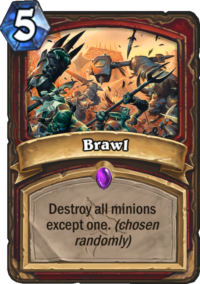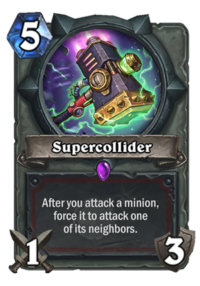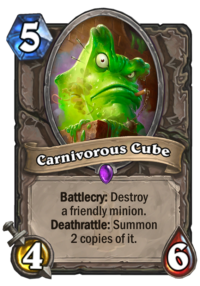Have you noticed how nothing seems to be a safe play anymore in the game? Gone are the guarantees of problematic threats, approaches which are nigh unanswerable by a specific class. Back in 2014, each and every hero had their well-defined strengths and weaknesses, a feature which has been consistently muddled by the plethora of new releases over time. Unfortunately, a homogeneous ladder experience is nothing new in Hearthstone, but this specific cause of it is a new cause behind the phenomenon and may be one of the more underappreciated reasons behind the community’s disappointment in an otherwise fairly varied metagame.
Boulevard of Broken Barriers
A long time ago, in a tavern far, far away, the classes of Hearthstone had widely different pros and cons, facets of the game they’ve excelled at and elements they’ve consistently struggled with. A few years, many sets and an entire rotation system have come and gone since, and the ladder environment in The Boomsday Project is full of oddities where classes are having a whale of a time doing things they really weren’t supposed to do based on the Classic set.

In a sense, this is unavoidable: after all, a decent chunk of yet-unexplored design space is predicated upon the things certain classes were forbidden to do initially, and it is understandable that certain portions of such territory will drift in and out of the Standard environment. The problem is that instead of giving us an occasional taste of conquered weaknesses, Team 5 seems intent on permanently plugging in the holes that are baked into the class-specific strategies that are governed by the Classic set. Sometimes, even this extreme approach makes sense – just consider Priest, a class that is on permanent life support when it comes to potent board clears. Originally, it was Lightbomb, then Dragonfire Potion, now Psychic Scream and Spirit Lash that had to be printed in order to counteract one of their serious weak points. However, there’s a difference between keeping a class functional and patching up their built-in weakness for no real reason.
The current state of Warrior’s supercharged control archetype is an excellent example of this phenomenon. The class has always been great at dealing with individual threats. Execute and Shield Slam are omnipresent and ultra-powerful tools against large minions, and the former was even featured in aggressive decks back when it only cost one mana while weapons also provide guaranteed value against most smaller critters when used as part of a control strategy. However, they were deliberately designed to struggle against larger boards: their Classic AoE card is the only one in the game that is guaranteed to not clear the entire field of play, meaning it has less of an impact in terms of initiative than what the other classes can dish out with a similar spell. Historically, two mid-sized minions were a Warrior’s worst nightmare: it’s terrible value to use Brawl and it’s also a waste to Execute either one of them, especially if you consider that neither approach actually alleviates the board pressure in its entirety.

Fast forward to 2018 and now Warrior has both Warpath and Reckless Flurry available for proper full clears depending on the archetype plus Supercollider to deal with two mid-sized threats at the same time. The only reason these enhancements didn’t propel the class to the top of the metagame is that most of the other classes received a similar treatment over time.
A look at the game’s other classes tell a similar story. Warlock is now capable of healing on a reliable basis regardless of archetype, counteracting the main drawback behind its hero power, Druid’s traditional weakness to swarm attacks is no longer a thing thanks to a combination of Spreading Plague and an incredible ability to stall, Mage’s weakness to aggression is dampened by the health gain properties bestowed upon Jaina after she was robbed of Ice Block, Paladin is now reliably given cards that deal with large individual threats (a trend that began with League of Explorers’ Keeper of Uldaman), Rogue’s getting more and more value cards in a bit to make some sort of Burgle-based archetype a reality while Shaman has received strong health recovery and multiple additional board clears. In Hunter’s case, its current archetypes have hardly anything to do with the class’ original Beast-related synergies and tempo tools and are almost single-handedly enabled by Deathstalker Rexxar, a card that’s spiked in strength since the introduction of extra options with Rush, Lifesteal and Poisonous from the sets that weren’t going to be a part of its Zombeast pool initially. Of course, most of these issues can be pinned on the Death Knights, cards that are very interesting in concept but turned out to be fairly oppressive in practice, allowing every class to go for an infinite value generation strategy without much setup. No wonder the TBP feels boring to many despite the high number of viable decks!
Staying Neutral
This isn’t the first time in Hearthstone’s history when class identities get blurred to a problematic extent: MSoG’s tri-class cards diminished the set’s neutral pool so much that it was hard to run any kind of deck that wasn’t dedicated to one of the gangs’ strategies, and the inclusion of many powerful neutral tempo cards later down the line created the infamous “neutral package” that began with Patches the Pirate and Prince Keleseth and went all the way up to Corridor Creeper and Bonemare, allowing literally every class at one point to run a viable pirate deck. Today, arguably the strategies featuring Carnivorous Cube and Devilsaur Egg are heading in a different direction, currently showing up in four classes (Hunter, Warlock, Rogue and Paladin) with certain experimental Priest builds also joining in on the fun.

Back in the Year of the Mammoth, it took a combination of nerfs and rotations to break up the powerful neutral package, and it was clear that the combination of these cards were never meant to be as powerful and omnipresent as they turned out to be. In the case of today’s patched-up class weaknesses, the homogeneous nature of the field seems to be more by design than accidental – and even if the Death Knights’ eventual rotation will definitely ease these particular woes, the fact that the different deck strategies don’t have to take their respective classes’ core strengths and weaknesses into account as much as before will likely plague Hearthstone way beyond 2019’s first set unless a change in design approach is made by Team 5. Who knows, it might just happen – it only took them a single month to completely change their mind on Giggling Inventor, after all…

I think, the biggest problem in entire game is that there are no clear win conditions and combos.
Most of the time is stalling till you get opponent exhausted of resources.
And there somewhere between we got aggro meaningless and brainless decks cause is the only way to defeat the meaningless “combo”/control decks.
In the other hand, “combo” decks & decks with clear win conditions are unbalanced and have less chances to pull out those.
In past we had problems with rng, but now things are so much out of control that even rng is irrelevant.
It’s just highroll skyrocket meta and things getting worse…
Really insightful, thanks for sharing.
The long-running HS thread on my board game community had gone very quiet of late, so I resurrected it. And I found, to my shock, I was the only one still playing regularly. Everyone else – who’d got all excited when Boomsday hit – had given up citing a stale meta. I found that surprising, given the variety of viable decks right now.
But I think you’ve hit on why it *feels* stale, even when the number of decks in circulation suggests otherwise. The Death Knights are a big part of it, for sure, forcing the game away from the careful balance of aggro vs control toward long-term value generation. Mid-range seems to have been completely squeezed away.
Following this argument to its logical conclusion, you could make the same accusation about Genn and Baku. Not in the sense that they’re value generators, but that they crush diversity in the meta. Not only are they ubiquitous in themselves, but each deck – odd and even – has particular high-value cards that you see over and over. So you could have eighteen decks, odd and even for each class, and have the sense you’re only playing against a handful of different archetypes.
To be fair to Blizzard, these cards are imaginative attempts to enliven the game’s limited pool of mechanics. But ages ago I did an interview with one of the HS team and asked him, in all earnestness, how did they manage to test the vast possible range of interactions with every expansion. The answer? They don’t, of course. And this is what happens as a result.
Cards like Megathun and other “win the game” cards need to be permanently eliminated. Class, minions, spells don’t matter- just get to the “I win” card
I’m honestly fine with Mechathun and pally DK. Alternate win conditions are fine so long as they’re sufficiently challenging to pull off, take MTG’s Door to nothingness as an example. They’re interesting because by working towards a nonstandard win condition you can confuse your opponent by making “sub optimal” plays for a standard deck and then flip it on them by revealing that you weren’t playing towards the same goal as them.
Coulden’t agree more. You worked your ass off to put up the game in your favour and you lose to one card. Allso getting rushed in 4 turns feels bad and underserved.
There shouldn’t BE class weaknesses. Class weaknesses just meabs you’re playing a 9 option game of tock paper scissors. This game is supposed to be skillful, match ups shouldn’t ever be tilted significantly in one direction.
rock, paper, scissors is a balanced game. if you spam rock, you’re eventually gonna lose to paper. if all you do is use the top druid (as an example of an oppressive class currently) decks, another class should logically be your weakness. one class shouldn’t be able to counter all archetypes, skilled or not.
Having a weakness means one is required to play around it. It makes for more decision making when crafting and playing. Without a general weakness, it shifts the meta into “I hope I have keleseth on turn 2.” I love some Mammoth, but it has some of the most oppeessive cards ever made. Neutrals are to strong, and there is little remaining in terms of class identity. Team 5 needs to nerf more neutrals, but does not want to piss off casuals.
Truth is Blizzard purposefully prints this cards in order to sell more packs. One thing in common between most of the cards mentioned in the article was their high rarities. They are pushing high powered epic cards to make it more expensive to players. I’d love to play priest but I just can’t keep affording two epic class cards that only go into 1 or 2 decks.
In my oppinion, the dillution of class identity originates in Blizzard’s ongoing ‘masterplan’ to continuously rearrange the classes’ power level. If it is decided to bring Druid to the top, well, this can only be done by erasing certain class-specific weaknesses. One could argue that in this example, they did it rather creatively; instead of ‘printing’ more efficient aoe, they gave the class armor and taunts.
On the other hand, when a class should be weaker, they go as far as to actively remove ‘identity’ … Fiery War Axe was a Warrior signature card as was Mana Wyrm for Mage.
tl;dr Blizzard’s focus is on power level (maybe on archetypes) far more than it is on class identity.
Maybe they think that identity is given simply due to the fact that there are class cards?
Maybe the class system (or the fact that classes usually cannot be ‘mixed’) is the core of the problem? In Magic the Gathering, you don’t have to dillute color identity because you are allowed to lessen their weaknesses by combining them with other colors. In this context, maybe the x-class concept presented in MSoG is the way to go for HS (if done right).
Given the limited possibilities with the central concepts of cards – they do damage, have health, cost mana – especially in the classic set, I find the flavour of the classes surprisingly varied in their classic form. This is indeed diluted now, and the article pinpointed that. As a longtime casual f2p-player I crafted Whizbang on day one and never bothered with deckbuilding, and the article made me realise why I don’t feel the urge to create something: when all classes feel the same, theres no space to make something unique and surprising.
The current meta, unfortunately, is the Hearthstone we love, fading increasingly into RNGstone. It saddens me watching the pros play in these tournaments – so seldom are the matches actually decided by gameplay. As much as I enjoy the game, it continues to shift in the wrong direction.
Actually most games are matchup driven. Ring doesn’t even have a big foot hold in the game right now. Super collider and guldan are the only English cards that are meta. So idk where ur statements are coming from
How is guldan rng?
Whatever it’s gonna be, I hope it’s gonna revive minion combat a bit more. I don’t like it when minions are somewhat meaningless to the overall game plan in almost every deck because getting to a certain Win Condition + Combo + ??? at some point is more important than taking smart trades and developing a little inbetween. I wanna play Tempo Rogue again which is absolute trash tier right now.
Combo clown fiesta AND Baku! 1 1/2 years to oppress standard meta for that card, especially if rotation can solve general problems like combo/solitaire playstyle and druid core.